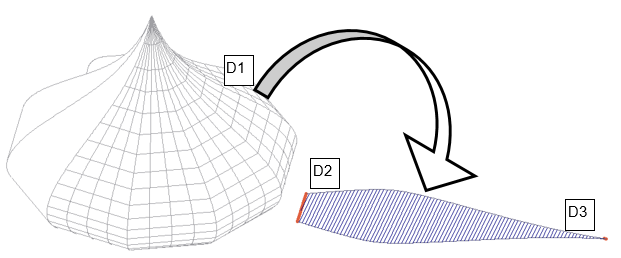Create Flat Pattern
Create Flat Pattern
The Flat-Pat command is used to facilitate the unfolding of surfaces drawn to represent special roof features such as domes, spires or tapered gutters. Users can take a three dimensional model and unfold its surfaces to produce cutting templates or flat patterns for manufacturing. It also provides allowances to plate thickness and neutral axis depth, so that accurate repeatable results can be obtained. Flat planes, ruled surfaces and cylinders can be unfolded. A tutorial on the practical use of this function is described here.
The Create Flat Pattern > Rul-Sur command can be used to unfold general ruled surfaces apart from cylinders. Some reservations apply when using this option for the following reasons:
There is no provision for bend allowance with the Flat-Pat Rul-Sur command. The model to be unfolded will be understood to represent the neutral surface. This is fine when the material is relatively thin compared to its extent (e.g. tapered gutters etc.)
Ruled surface entities are constructed by generating rulings at equal spacing along two generator curves (the section curve of a dome for example). Sometimes, the surface will be twisted as well as bent. A twisted surface cannot be unfolded without also drawing or stretching the material. The Rul-Sur command still produces a result, but the outline created is an approximation. Some ruled surfaces are not twisted. If one of the generators is a point, the surface will not be twisted. If the two generators are always parallel the surface will not be twisted. This is the case if one generator curve is a scaled, translated (but not rotated) copy of the other.

When selected, the system prompts for the location of the ruled surface near the edge to unfold.
1 Select the ruled surface by one of its ‘straight’ edges at the end to start the unfold process from.
After selection, the system prompts you to locate the position to unfold the surface.
2 Locate a point on the CPL to use as the corner of the unfolded surface.
Next, locate another point to indicate the direction to unfold the surface.
Surface Flat-Pat Ru-Sur
D1 – Locate ruled surface
D2 – Position to unfold surface
D3 – Direction to unfold surface
Locate a point to show the direction to unfold the surface. The surface will be unfolded in the x-positive or x-negative direction depending on the placement of the located point.
When unfolded, the flat pattern outline is represented by two lines and two curves. There is no opportunity to rotate other entities that may depend from the ruled surface. If the desired flat pattern includes a series of planes and unfolded ruled surfaces (e.g. a square-round duct transition) then the separate unfolded surfaces and planes must be separately translated and rotated to bring them together as a single pattern.


Comments are closed.